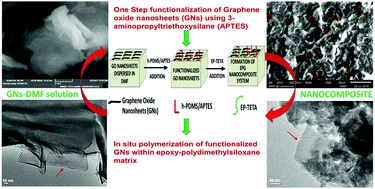Preparation of hydrophobic epoxy–polydimethylsiloxane–graphene oxide nanocomposite coatings for antifouling application†
Abstract
Epoxy–polydimethylsiloxane–graphene oxide (EPG) nanocomposite coatings were successfully developed by loading different wt% of graphene oxide nanosheets (GNs) into an epoxy–hydroxy-terminated-polydimethylsiloxane (EP–hPD) matrix via a facile in situ preparation technique. The inclusion of GNs into EPN led to an increase in modulus of elasticity and tensile strength up to 1570.46 MPa and 31.54 MPa, respectively, in the case of 1 wt% loading of GNs in the EP–hPD matrix. Also, an increase in the water contact angle from 90.1° to 115.2°, 104.5° and 101.7° was discerned at 1, 3 and 5 wt% loadings of GNs respectively. Taber abrasion results demonstrated a decrease in abrasion loss by 33.3% at 1 wt% loading of GNs in comparison to the unreinforced coating. An improvement in the glass transition temperature (Tg) was observed from 63.5 °C for the neat sample to 77.6 °C, 76.3 °C and 71.6 °C for the 1, 3 and 5 wt% EPG nanocomposites, respectively. An inevitable enhancement in the properties of the nanocomposites was affirmed due to the synergistic effect of GNs dispersed within the EP–hPD blend matrix. The prominent findings of this work include a minimum corrosion rate of 0.73 × 10−2 mm per year and upgradation in the antifouling performance of the nanocomposite coatings in comparison to the neat coating.

- This article is part of the themed collection: Soft Matter Most Popular 2020


 Please wait while we load your content...
Please wait while we load your content...